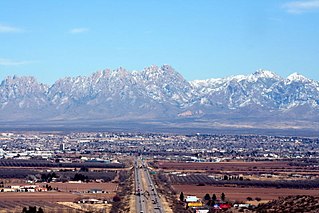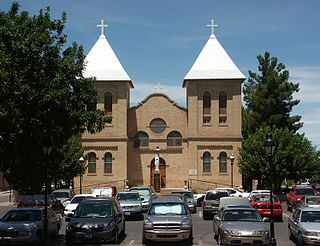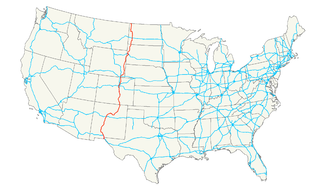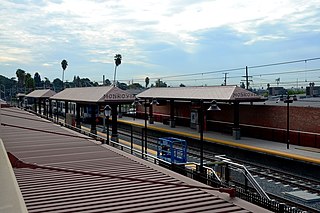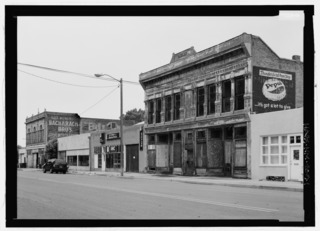Mesilla Park | |
|---|---|
Neighborhood | |
| Coordinates: 32°16′33″N106°46′00″W / 32.27583°N 106.76667°W Coordinates: 32°16′33″N106°46′00″W / 32.27583°N 106.76667°W | |
| Country | United States |
| State | New Mexico |
| County | Doña Ana |
| Elevation | 3,878 ft (1,182 m) |
| Population | |
| • Total | 2,560 |
| Time zone | UTC-7 (Mountain (MST)) |
| • Summer (DST) | UTC-6 (MDT) |
| ZIP codes | 88047 [1] |
| Area code(s) | 575 |
| GNIS feature ID | 899786 [2] |
Mesilla Park, New Mexico is a unincorporated town included in the Las Cruces Metropolitan area.
History
In 1880 after the Mesilla Valley was bypass by the Southern Pacific Transportation Company because they choose a more direct route South to El Paso, Texas. As a result The Atchison, Topeka and Santa Fe Railway built a line down from Albuquerque, New Mexico to Rincon, New Mexico first approached Mesilla with offers to extend the railroad lines to the town as it was the larger community, better organized, and the county seat. Residents, however, did not want to give up land for a right-of-way. Over in Las Cruces, four men founded the Las Cruces Town Company: William Rynerson, Henry Cuniffe, Simon Bolivar Newcomb, and Jacinto Armijo bought up farmland west of the town, including Armijo’s, and offered some of it to the Atchison, Topeka and Santa Fe. That sealed the deal. The railroad extend the line from Rincon, New Mexico, to El Paso, Texas, through Las Cruces, New Mexico three miles away from Mesilla, New Mexico . The first train arrived on April 26, 1881, to about as much pomp and celebration as the little town could muster. In the spring of 1887, a plan was quickly devised, and the Bowmans and Chavez sold portions of their properties to Edward Wilder, Atchison, Topeka and Santa Fe Railway Board Director, Secretary and Treasurer, stipulating that Atchison, Topeka and Santa Fe Railway would construct a depot that would stop for passengers and freight, install a telegraph operator, and that all the improvements would be made by September 1, 1887. Bowman and Chavez were investing in their land holdings, which were sold as Mesilla Park. To begin, Atchison, Topeka and Santa Fe Railway incorporated The Rio Grande Land Company on June 23, 1887 by authorizing $250,000.00 in capital stock. The Rio Grande Land Company filed the Mesilla Park townsite plat with Dona Ana County on August 25, 1887 on land on previously owned by farmers on August 25, 1887. The townsite plat filed was an irregular grid pattern of streets bounded by the meandering curvature of the old Rio Grande River to the east and south, with Sixth Street on the north now Conway Avenue, and a diagonally drawn boundary line on the west. Within the boundaries were forty-four blocks, or portions of blocks, divided into lots of varying sizes based on their use as commercial, industrial, residential, and agricultural property. Two-hundred lots were laid out ranging in size from 25 x 134 feet to several acres. Oak, Maple now Main Street, Locust now Harrelson, Linden, and Orange avenues paralleled the railroad tracks. Perpendicular to these were Union, Fourth now Bell, Fifth now Manso, and Sixth now Conway streets. The Atchison, Topeka and Santa Fe Railway was not the only factor that influenced the growth of Mesilla Park. As early as 1886, Las Cruces leaders and education advocates spoke out for the creation of an agricultural college in southern New Mexico. This resulted in the creation of the New Mexico State University on September 17, 1888. Less than a year later, the legislature authorized the creation of the University of New Mexico in Albuquerque, The School of Mines in Socorro, and The Insane Asylum in Las Vegas. New Mexico State University official opened for its first semester on January 21,1890 to the east of Mesilla Park. Now Early business during the growth included general stores, grocery stores, the original United States Post office at 3225 Main Street, Mesilla Park, New Mexico, 88047, a Wells-Fargo Express Office, Western Union Telegraph Agent, barber shop, several hotels, ice house, a wooden Atchison, Topeka and Santa Fe Railway Depo and a horse livery with blacksmith shop. In 1894, George D. Bowman filed the Bowman Addition to the Mesilla Park townsite, which expanded on the original townsite plat and added two new streets on the north, College and University avenues, and Bowman Avenue on the west. In 1906, three years after George D. Bowman's death, the Bowman Addition was amended, by his son, Henry D. Bowman, for the purpose of designating a site for a public school. The original Mesilla Park Elementary School was built on this lot beginning in 1907. In 1925 the original wooden Atchison, Topeka and Santa Fe Railway train depot was closed with the grand opening of a Spanish-Pueblo Revival-style depot that is still used today as a Burlington Northern Santa Fe maintenance office and storage yard. During the Great Depression and drought of the 1930s, New Mexico State University, dramatically expanded course offerings to include the arts and sciences along with home economics and business administration. In the 1933-1934 academic year the chemistry enrollment for a Bachelor's of Science degree was fifty percent of the total enrollment of 475. Also in the 1930s, drama, English, creative writing, and debate were offered. As the course offerings expanded, student enrollment followed with the next year to 558 students, and in the 1938-1939 academic year it increased to over one-thousand students. The college expansion resulted in a need for housing for new faculty, staff, and students in the community. In 1964 the community was annexed by "Las Cruces", when Atchison, Topeka and Santa Fe Railway, finally disconnected passengers services do to the rise in automobiles and airplane traffic. In 1970 the New Mexico section of Interstate 10 building causing one original block on the east side to be taken by intimate domain with an on ramp even being built over an original road. As of 2021 Mesilla Park still has its own post office with ZIP code 88047, which opened in 1997 at its current location at 310 East Union Avenue, Mesilla Park, New Mexico, 880047. [1] [3] [4]


